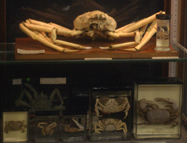
SUBPHYLUM CRUSTACEA
Crustaceans (42000 species) are distinguished from Chelicerates and Uniramians by their branched limbs. Crustaceans are mainly an aquatic group; only slaters and woodlice have adapted to land and they are confined to humid, dark habitats. As the dominant marine arthropods, crustaceans occupy a central and essential position in aquatic food webs. Sea-birds and octopuses are the most common predators of larger crustacea. The sub-phylum Crustacea comprises ten classes of very diverse animals, some of which are important as food for humans. Many crustacean orders include a wide range of little known and often very bizarre parasites.
The body is usually divided into head, thorax and abdomen. Its cuticle is often impregnated with calcium salts and provides an extremely tough covering. A carapace may shield the head and part of the thorax..
The appendages are split near the base into two branches, which may also be branched. There are five pairs of head appendages: antennules on the first segment; antennae on the second segment; mandibles, for crushing and grinding, flank the mouth on the third segment; maxillae, accessory mouth parts, on the fourth and fifth segments. The anterior thoracic limbs may also be adapted for manipulating food (they are then called maxillipeds). The rest of the thoracic and abdominal appendages are commonly adapted for different functions – swimming, respiration and brooding young. In general the less differentiation among the limbs, the more primitive an organism is considered to be.
Many small crustacea feed by filtering plankton from the water with their bristle-fringed mouthparts. Others are carnivores, actively capturing prey. Large crustacea are hunters and scavengers with special, often clawed appendages adapted for grasping and crushing living organisms or carrion.
A larval stage known as a nauplius with three pairs of legs occurs at some stage of the development of all crustaceans - either within the egg or as a free-swimming larva. The nauplius eye is a collection of photoreceptors, which may persist in some adult forms. Adults may have a compound eye. The young may pass through a number of other stages: the zoea of crabs, the cypris of barnacles. In larger crustacea particularly, fertilisation is achieved through copulation and the eggs are brooded in a pouch or attached to special brooding appendages before the larvae are released. Some crayfish give birth to live young that cling to their mother’s back, looking like small adults. The barnacles are the only hermaphroditic class. In the parthenogenic water-fleas reproduction normally occurs without fertilisation as males are only produced sporadically.
Of the ten classes of Crustacea, five classes consist of very small animals and are not illustrated here: Classes Cephalocarida, Remipedia, Mystacocarida, Tantulocarida, Branchiura.
|
||||||||||||||||||||||||||||||||||||||||||||||||||||||||||||||||||||||||||||||||||||||||||||||||||||||||||||||||||||||||||||||||||||||||||||||||||||||||||||||||||||||||||||||||||||||||||||||||||||||||||||||||||||||||||||||||||||||||||
Select an area or choose a link for more information.

















